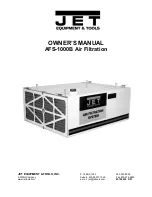
20
d. To determine unit airflow, in CFM, measure the voltage
corresponding to the current conditioning call, and
measure the external static pressure in the plenum, at
least 18” from the unit or nearest transition point. Locate
the static pressure on the left side of the charts (Figure
3.2/3.3/3.4) and read across until you reach the curve
corresponding to the measured voltage. From the point
where this crosses, drop a line straight down to read the
airflow at the bottom of the chart. For system settings of
1.2" static pressure, refer to tables in Figures 3.21, 3.31
and 3.41.
e. To adjust airflow, locate the nearest system curve, and
follow parallel to this curve while adjusting the signal
voltage to achieve the desired airflow. If the static pressure
falls above or below the desired operating range for the
given airflow, then the air delivery system must be
adjusted. To lower static pressure, provide additional
outlets to the system, to raise the static pressure, install
restrictor orifices as described in the Installation and
Operations Manual.
f. Replace the speed control cover.
5. Check that system static pressure is within acceptable
limits (minimum 1.2" WC - ,maximum 1.5" WC). You
can use a U-tube manometer to check the external
static pressure on the duct system.
1. Puncture a ¼" diameter hole in the plenum duct at
least 18" from the fan coil unit.
2. Insert the high-side manometer tube into the hole so
that the end is approximately flush with the inside wall
of the plenum, and perpendicular to the direction
of airflow.
3. System static pressure should be between 1.2"
and 1.5" WC.
a. If the pressure is higher than 1.5" provide additional
supply runs to increase airflow or lower the fan
speed by turning the fan speed adjustment for the
current mode of operation counter-clockwise to
reduce the static pressure.
b. If the pressure is lower than 1.2", look for leaks in
the supply plenum, restrictions in the return system
(including clogged filters) If more than the
recommended number of supply runs are installed,
you may install flow restrictors (orifices) in these
runs. If the number of runs is appropriate for the
load, increase the static pressure by turning fan
speed adjustment for the current mode of operation
clockwise to increase the static pressure.
6. Check that blower motor amp draw compares with
fan coil unit rating plate. Amp draw shown on plate is
the FLA of motor (not the actual running amps) and
will vary with the pressure and voltage.
7. Place the thermostat cooling indicator in COOL
position, which will start the outdoor unit. Let the
system run at least 30 minutes to stabilize operating
conditions.
FIGURE 3: SPEED CONTROL PANEL
Flo0
Fan Only
Flo1
Cooling
Flo2
Heating
Flo3
Stage 2
Cooling
Flo4
Stage 2
Heating
4
3
2
1
0
8. For outdoor unit start-up, follow manufacturer’s instructions.
9. Check that temperature drop across the water coil
in the indoor unit is between 20°F to 28°F.
10. Check the chiller or boiler for proper operation
according to the manufacturer’s instructions.









































